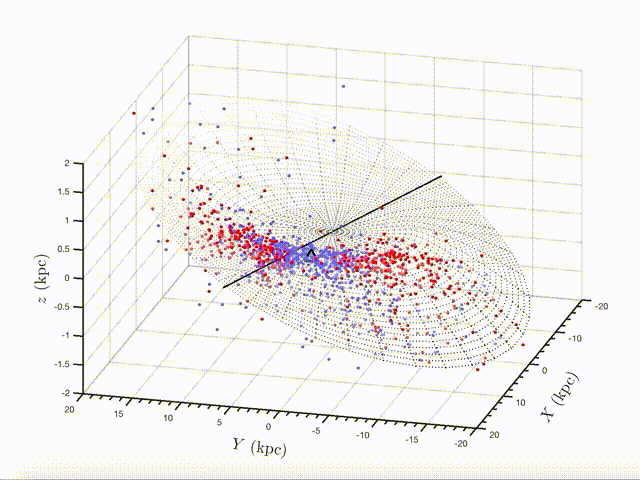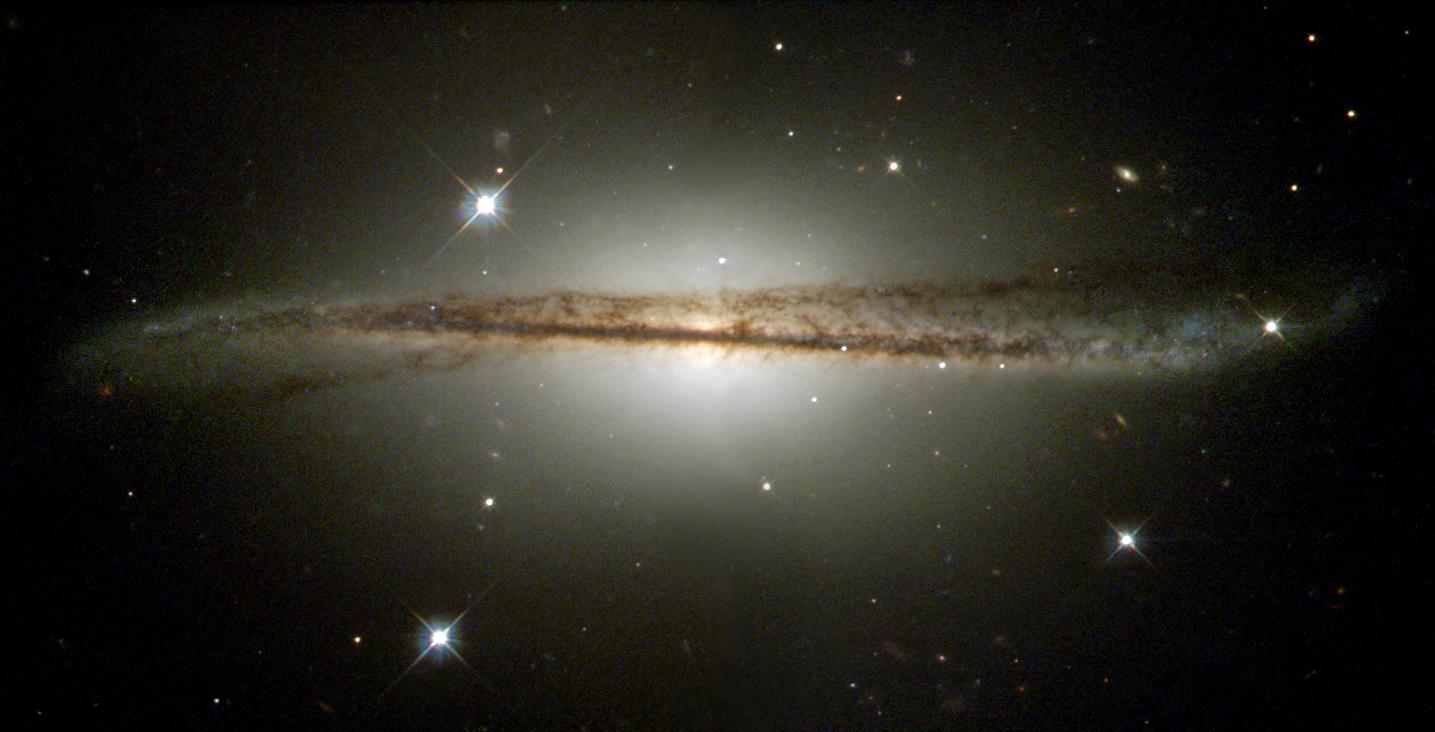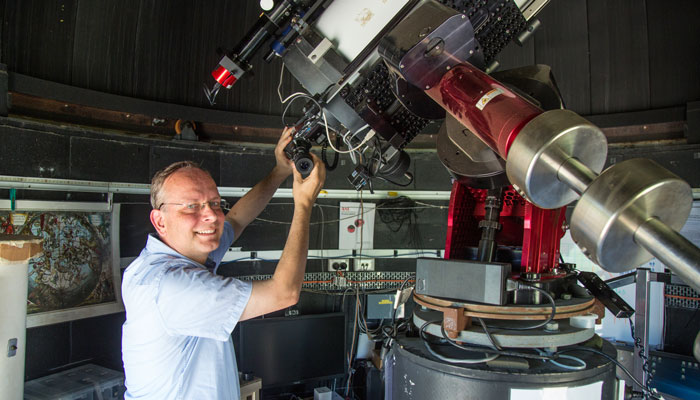First 3D Mapping of the Milky Way Reveals a Warped Galaxy
Special Stories
6 Feb 2019 9:04 AM
[Macquarie University] Our Milky Way galaxy’s disk of stars is anything but stable and flat. Instead, it becomes increasingly ‘warped’ and twisted far away from the Milky Way’s center, according to astronomers from Macquarie University and the Chinese Academy of Sciences, who have built the first accurate 3D map of Earth’s home galaxy and unveiled in a paper published in Nature Astronomy.
From a great distance, our galaxy would look like a thin disk of stars that orbit once every few hundred million years around its central region, where hundreds of billions of stars provide the gravitational ‘glue’ to hold it all together.
But the pull of gravity becomes weaker far away from the Milky Way’s inner regions. In the galaxy’s far outer disk, the hydrogen atoms making up most of the Milky Way’s gas disk are no longer confined to a thin plane, but they give the disk an S-like, warped appearance.
 [Animation of the 3D map of Cepheid variable stars in the Milky Way, revealing its warped shape.]
“It is notoriously difficult to determine distances from the sun to parts of the Milky Way’s outer gas disk without having a clear idea of what that disk actually looks like,” says Xiaodian Chen, a researcher at the Chinese Academy of Sciences in Beijing and lead author of the article in Nature Astronomy.
“However, we recently published a new catalogue of well-behaved variable stars known as classical Cepheids, for which distances as accurate as 3 to 5 per cent can be determined.” That database allowed the team to develop the first accurate three-dimensional picture of our Milky Way out to its far outer regions.
Classical Cepheids are young stars that are some four to 20 times as massive as our Sun and up to 100,000 times as bright. Such high stellar masses imply that they live fast and die young, burning through their nuclear fuel very quickly, sometimes in only a few million years.
[Animation of the 3D map of Cepheid variable stars in the Milky Way, revealing its warped shape.]
“It is notoriously difficult to determine distances from the sun to parts of the Milky Way’s outer gas disk without having a clear idea of what that disk actually looks like,” says Xiaodian Chen, a researcher at the Chinese Academy of Sciences in Beijing and lead author of the article in Nature Astronomy.
“However, we recently published a new catalogue of well-behaved variable stars known as classical Cepheids, for which distances as accurate as 3 to 5 per cent can be determined.” That database allowed the team to develop the first accurate three-dimensional picture of our Milky Way out to its far outer regions.
Classical Cepheids are young stars that are some four to 20 times as massive as our Sun and up to 100,000 times as bright. Such high stellar masses imply that they live fast and die young, burning through their nuclear fuel very quickly, sometimes in only a few million years.
 [The galaxy above, ESO 510-G13, is an edge-on warped spiral galaxy. Similar to the Milky Way, it has a pronounced warp in its gaseous disc and a less pronounced warp in its disc of stars. Image credit: NASA/Space Telescope Science Institute]
They show day- to month-long pulsations, which are observed as changes in their brightness. Combined with a Cepheid’s observed brightness, its pulsation period can be used to obtain a highly reliable distance.
“Somewhat to our surprise, we found that in 3D our collection of 1339 Cepheid stars and the Milky Way’s gas disk follow each other closely. This offers new insights into the formation of our home galaxy,” says Macquarie University’s Professor Richard de Grijs, astronomer and senior co-author on the paper.
“Perhaps more important, in the Milky Way’s outer regions, we found that the S-like stellar disk is warped in a progressively twisted spiral pattern.”
[The galaxy above, ESO 510-G13, is an edge-on warped spiral galaxy. Similar to the Milky Way, it has a pronounced warp in its gaseous disc and a less pronounced warp in its disc of stars. Image credit: NASA/Space Telescope Science Institute]
They show day- to month-long pulsations, which are observed as changes in their brightness. Combined with a Cepheid’s observed brightness, its pulsation period can be used to obtain a highly reliable distance.
“Somewhat to our surprise, we found that in 3D our collection of 1339 Cepheid stars and the Milky Way’s gas disk follow each other closely. This offers new insights into the formation of our home galaxy,” says Macquarie University’s Professor Richard de Grijs, astronomer and senior co-author on the paper.
“Perhaps more important, in the Milky Way’s outer regions, we found that the S-like stellar disk is warped in a progressively twisted spiral pattern.”
 [Macquarie University astronomer Professor Richard de Grijs is the co-author of a paper published in Nature Astronomy today that found the Milky Way's disc of stars becomes increasingly twisted the further away the stars are from the galaxy's centre.]
This reminded the team of earlier observations of a dozen other galaxies which also showed such progressively twisted spiral patterns.
Combining their new results with those other observations, the researchers concluded that the Milky Way’s warped spiral pattern is most likely caused by ‘torques’ – or rotational forcing – by the massive inner disk.
“This new morphology provides a crucial updated map for studies of our galaxy’s stellar motions and the origins of the Milky Way’s disk,” according to Licai Deng, senior researcher at the Chinese Academy of Sciences and co-author on the paper.
Edited for WeatherNation by Meteorologist Mace Michaels
[Macquarie University astronomer Professor Richard de Grijs is the co-author of a paper published in Nature Astronomy today that found the Milky Way's disc of stars becomes increasingly twisted the further away the stars are from the galaxy's centre.]
This reminded the team of earlier observations of a dozen other galaxies which also showed such progressively twisted spiral patterns.
Combining their new results with those other observations, the researchers concluded that the Milky Way’s warped spiral pattern is most likely caused by ‘torques’ – or rotational forcing – by the massive inner disk.
“This new morphology provides a crucial updated map for studies of our galaxy’s stellar motions and the origins of the Milky Way’s disk,” according to Licai Deng, senior researcher at the Chinese Academy of Sciences and co-author on the paper.
Edited for WeatherNation by Meteorologist Mace Michaels
 [Animation of the 3D map of Cepheid variable stars in the Milky Way, revealing its warped shape.]
“It is notoriously difficult to determine distances from the sun to parts of the Milky Way’s outer gas disk without having a clear idea of what that disk actually looks like,” says Xiaodian Chen, a researcher at the Chinese Academy of Sciences in Beijing and lead author of the article in Nature Astronomy.
“However, we recently published a new catalogue of well-behaved variable stars known as classical Cepheids, for which distances as accurate as 3 to 5 per cent can be determined.” That database allowed the team to develop the first accurate three-dimensional picture of our Milky Way out to its far outer regions.
Classical Cepheids are young stars that are some four to 20 times as massive as our Sun and up to 100,000 times as bright. Such high stellar masses imply that they live fast and die young, burning through their nuclear fuel very quickly, sometimes in only a few million years.
[Animation of the 3D map of Cepheid variable stars in the Milky Way, revealing its warped shape.]
“It is notoriously difficult to determine distances from the sun to parts of the Milky Way’s outer gas disk without having a clear idea of what that disk actually looks like,” says Xiaodian Chen, a researcher at the Chinese Academy of Sciences in Beijing and lead author of the article in Nature Astronomy.
“However, we recently published a new catalogue of well-behaved variable stars known as classical Cepheids, for which distances as accurate as 3 to 5 per cent can be determined.” That database allowed the team to develop the first accurate three-dimensional picture of our Milky Way out to its far outer regions.
Classical Cepheids are young stars that are some four to 20 times as massive as our Sun and up to 100,000 times as bright. Such high stellar masses imply that they live fast and die young, burning through their nuclear fuel very quickly, sometimes in only a few million years.
 [The galaxy above, ESO 510-G13, is an edge-on warped spiral galaxy. Similar to the Milky Way, it has a pronounced warp in its gaseous disc and a less pronounced warp in its disc of stars. Image credit: NASA/Space Telescope Science Institute]
They show day- to month-long pulsations, which are observed as changes in their brightness. Combined with a Cepheid’s observed brightness, its pulsation period can be used to obtain a highly reliable distance.
“Somewhat to our surprise, we found that in 3D our collection of 1339 Cepheid stars and the Milky Way’s gas disk follow each other closely. This offers new insights into the formation of our home galaxy,” says Macquarie University’s Professor Richard de Grijs, astronomer and senior co-author on the paper.
“Perhaps more important, in the Milky Way’s outer regions, we found that the S-like stellar disk is warped in a progressively twisted spiral pattern.”
[The galaxy above, ESO 510-G13, is an edge-on warped spiral galaxy. Similar to the Milky Way, it has a pronounced warp in its gaseous disc and a less pronounced warp in its disc of stars. Image credit: NASA/Space Telescope Science Institute]
They show day- to month-long pulsations, which are observed as changes in their brightness. Combined with a Cepheid’s observed brightness, its pulsation period can be used to obtain a highly reliable distance.
“Somewhat to our surprise, we found that in 3D our collection of 1339 Cepheid stars and the Milky Way’s gas disk follow each other closely. This offers new insights into the formation of our home galaxy,” says Macquarie University’s Professor Richard de Grijs, astronomer and senior co-author on the paper.
“Perhaps more important, in the Milky Way’s outer regions, we found that the S-like stellar disk is warped in a progressively twisted spiral pattern.”
 [Macquarie University astronomer Professor Richard de Grijs is the co-author of a paper published in Nature Astronomy today that found the Milky Way's disc of stars becomes increasingly twisted the further away the stars are from the galaxy's centre.]
This reminded the team of earlier observations of a dozen other galaxies which also showed such progressively twisted spiral patterns.
Combining their new results with those other observations, the researchers concluded that the Milky Way’s warped spiral pattern is most likely caused by ‘torques’ – or rotational forcing – by the massive inner disk.
“This new morphology provides a crucial updated map for studies of our galaxy’s stellar motions and the origins of the Milky Way’s disk,” according to Licai Deng, senior researcher at the Chinese Academy of Sciences and co-author on the paper.
Edited for WeatherNation by Meteorologist Mace Michaels
[Macquarie University astronomer Professor Richard de Grijs is the co-author of a paper published in Nature Astronomy today that found the Milky Way's disc of stars becomes increasingly twisted the further away the stars are from the galaxy's centre.]
This reminded the team of earlier observations of a dozen other galaxies which also showed such progressively twisted spiral patterns.
Combining their new results with those other observations, the researchers concluded that the Milky Way’s warped spiral pattern is most likely caused by ‘torques’ – or rotational forcing – by the massive inner disk.
“This new morphology provides a crucial updated map for studies of our galaxy’s stellar motions and the origins of the Milky Way’s disk,” according to Licai Deng, senior researcher at the Chinese Academy of Sciences and co-author on the paper.
Edited for WeatherNation by Meteorologist Mace MichaelsAll Weather News
More